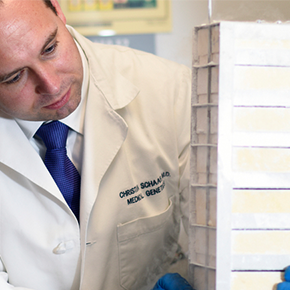In 2015, Dr. Lucy Liu, now a Ph.D. graduate in neuroscience from the Bellen lab, discovered that a number of genes involved in neurodegeneration promote damage to neurons and glia by inducing high levels of free radicals (oxidative stress) and accumulation of lipid droplets in glia. Liu continued this line of research and in 2017 … Continue reading
Monthly Archives: November 2017
How having too much or too little of CHRNA7 can lead to neuropsychiatric disorders
Studying the genetic code allows researchers to know whether some patients with neuropsychiatric disorders either have extra copies of the CHRNA7 gene or are missing copies. However, little was known about the functional consequences of this genetic imbalance in brain cells. “For several years we have been studying patients with these conditions in different ways … Continue reading
Analyzing cryo-electron tomography images just got faster
Researchers use cryo-electron tomography to visualize macromolecules frozen in action and details of structures inside of cells. This method provides 100 times better resolution than the best light microscope; this information cannot be obtained by any other current method. “However, the need for about one man-week of effort to manually annotate all of the 3-D … Continue reading
How estrogen regulates gene expression
Estrogens are a group of hormones that are essential for normal female sexual development and for the healthy functioning of the reproductive system. They also are involved in certain conditions, such as breast cancer. Estrogen also plays a role in male sexual function. These hormones carry out their functions by turning genes on and off … Continue reading
This two-step approach can expedite finding answers to complex genetic conditions
To function normally, the human brain requires the right amount of a number of proteins, including MeCP2. Having twice the normal amount of MeCP2, the result of having an extra copy of the gene MECP2, causes severe neurological disorders that include intellectual disability, autism spectrum disorders, motor dysfunction and other medical complications. “Animal models that … Continue reading
Muscle’s path to maturity follows the alternative splicing way
Compare the skeletal muscles of a newborn with those of an adult. While the former can barely move the body, adult muscles can perform record breaking feats of agility or strength. The path from one to the other involves more than growing in size, as research from the Cooper lab shows us. “The process of … Continue reading
More than an anticoagulant; heparin also promotes appetite in mice
Naturally-produced heparin is well-known for its role as an anticoagulant. Heparin is also widely used as a medication to prevent blood clotting. “In addition to its role as an anticoagulant, naturally-produced heparin has been known to affect other biological functions. In this study, we are among the first groups to investigated heparin’s potential role in … Continue reading
Image of the Month: The underappreciated astrocyte
The brain has billions of cells of which only 30 percent are neurons. Astrocytes are the predominant cell type of the remaining 70 percent. Surprisingly, these cells have not been studied in as much detail as neurons have. The laboratory of Dr. Benjamin Deneen is in part dedicated to filling this gap of knowledge about … Continue reading
Device that induces a mild localized ‘fever’ could treat vascular involvement in cancer
The prognosis of a cancer patient relies significantly on the ability of the surgeon to remove all the tumor, including a cancer-free boundary, leaving what surgeons call a tissue margin negative for cancer cells. But this is not always possible. Leaving tumor tissue behind reduces the patient’s chance for recovery because the unremoved tumor may … Continue reading








